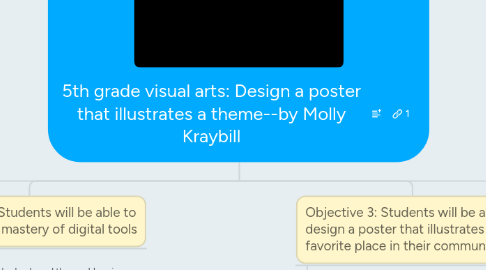
1. Objective 1: Students will be able to identify the main components of a poster design
1.1. Tap into prior knowledge about what students already know about what makes up a poster.
1.2. Pre-teach vocabulary words of poster design
1.3. Use a Think-Pair-Share strategy to allow students to process with a partner
1.3.1. I chose these strategies because I know that my students have had minor exposure to posters already through their art and science classes. I want to be able to access their prior knowledge in order to help them identify the parts that make up a poster.
2. Objective 3: Students will be able to design a poster that illustrates a favorite place in their community
2.1. Do a think aloud as I model the design process of creating my own poster
2.2. Use a sentence starter for students who may struggle with identifying a favorite place in their community
2.3. Create a graphic organizer to help students organize their poster sketches
2.3.1. I chose these strategies because I predict that some students will struggle with thinking of a favorite place in their community. My student population has a decent amount of ELL students, and I imagine the brainstorming part of this assignment could be challenging. Doing a think aloud and creating a graphic organizer can help students create effective and clear designs.
3. Objective 2: Students will be able to demonstrate mastery of digital tools
3.1. Model the tools clearly and thoroughly using my computer plugged into the Smartboard
3.2. Encourage students to use a graphic organizer to label tools and their purpose
3.3. Have directions printed out of how to open a new document, save, delete, etc.
3.4. Pre-teach Inkscape vocabulary before modeling the program
3.4.1. I chose these strategies because I already know that the computer program Inkscape can potentially be overwhelming to students. I will ease students into the program by first teaching them the vocabulary, and modeling tools clearly. A majority of my students have exposure to technology already and will enter with prior knowledge, but I cannot assume that they can reach independence in the tools right away.
4. Objective 4: Students will be able to evaluate their work based on a rubric.
4.1. Create a visual of posters that meet each score of the rubric. For example, a poster that meets a low level 1, and a poster that meets a high level 4.
4.2. Do a think aloud of modeling how I would grade my work based on the rubric. Check for understanding of why I graded myself for a specific category
4.3. Probe students about what they notice in my work and how they could make their work reach the next level on the rubric
4.3.1. I chose these strategies because I think it will be challenging for students to critique their own work. From my experience, it is hard for my younger students to be critical about their artwork and work towards making it better. These scaffolding strategies will help my students effectively look closely at their work and reflect on their own design process.
